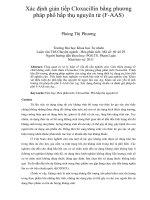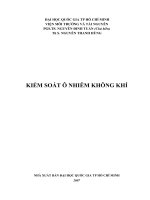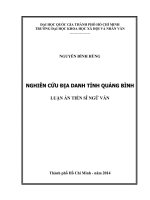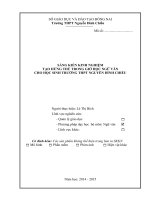Nguyen dinh hung AAS
Bạn đang xem bản rút gọn của tài liệu. Xem và tải ngay bản đầy đủ của tài liệu tại đây (4.25 MB, 12 trang )
“The light of Buddhism shines again in the South”:
The reasons for the woodblock printing plate engraving of
Buddhist scriptures in Northern Vietnam when exposed
to the Japanese canons in the early 20th century
Nguyen Dinh Hung
1
introductions
•
•
•
•
•
Three sets of Japanese canon , French School of the Far East in Hanoi
A movement of printing Mahayana scriptures in Chinese
Five major Buddhist sơn môn (Dharma school) in the North
The flow of Chinese Buddhism, Ming-Qing Buddhism
Source material: Japanese canons, statistics of printed scriptures, analysis of the prologues and
epilogues in those writings, Buddhist historical documents
2
1. The context of Buddhist documents in Chinese characters in Northern Vietnam
•
Mahayana
Buddhism,
Chinese characters.
•
Buddhist canons from China (10 th – 14 th
century)
•
From 17th century: influence of Chinese
Buddhism from the late Ming to early
Qing.
•
1730s: The trip of the monk Tính Tuyền 性
性 to Guangzhou to ask for scriptures.
(300 volumes (about 1000 scrolls), placed
in the Càn An 性性 pagoda (Thăng Long 性
性 ).
scriptures
in
Yunqi Zhuhong 性性性性 , Minh – Qing dynasties monk ( 性性性 ,
woodblock carving in Vietnam
in early 20
3
th
century)
1. The context of Buddhist documents in Chinese characters in Northern Vietnam
•
•
“Luckily, they met a sage who was a Chinese
Other
ways
of
importing
scriptures:
activities
of
delegations , brought over by
Chinese monks , bought and
brought
over
by
Chinese
merchants…
merchant named Guan Lichu
性 性 性 , living on
Hàng Cân 性 性 street, who has a heart for the
Dharma, belief and respect for the Three
Jewels. He asked people to return to China to
buy
sutras,
such
a
good
thing.
The
Mahasaṃnipata Sutra 性性性性性性 , the Mahayana
19th - early 20th century the
Buddhist community in the
North mainly relied on books
purchased
by
Chinese
merchants, and had much
fewer resources than other
Buddhist centres in Vietnam.
Prajnaparamita Sutra 性性性性性性性 , each with 30
scrolls, first engraved the printing plates for
the Mahayana Prajnaparamita, then for the
Mahasaṃnipata Sutra).”
The prologue of Mahayana Prajna Sutra
性性性性性性性
(copy kept at Liên Phái
pagoda, Hanoi)
4
2. “Three Japanese Buddhist canons" - The Japanese canons in the library of the French School of the Far East in Hanoi in the
early 20th century
- The Great Japanese collated edition of
Tripitaka 性 性 性 性 性 性 性 性 (Hongjao canon 性 性 性 ),
printed by Hongjao publisher 性 性 性 性 around
1880 – 1885.
- The Great Japanese collated edition of
Tripitaka with reading instruction marks 性性性性
性 性 性 性 性 性 (Wanzheng canon 性 性 性 ), printed by
Cangjing Academy 性性性性 around 1902 – 1905.
- Supplement to the Japanese edition of the
Tripitaka 性性性性性性 (Wanxu canon 性性性 ), printed
by Cangjing Academy 性 性 性 性 around 1905 –
1912.
Library of Social Sciences (1 Liễu Giai street, Hanoi)
5
3. The trend of printing woodblock engraving from the Japanese canons in Northern Vietnam in the early 20th
century
•
13 th – 20 th century: the operation of printing
woodblock engraving gradually shifted from being
in charge by the imperial court to the monastic
community.
•
“sơn mơn 性性” (dharma school, similar to a fapai 性
性 ).
•
5 major sơn môn: Tế Xuyên Bảo Khám (Hà Nam),
Vĩnh Nghiêm (Bắc Giang), Bổ Đà (Bắc Giang), Liên
Phái (Hanoi), Linh Quang (Hanoi)
Part of the list of monks who contributed money to the printing
6
of sutras.
( 性性性性性 Hanoi, early 20th century)
3. The trend of printing woodblock engraving from the Japanese canons in Northern Vietnam in the early 20th
century
7
3. The trend of printing woodblock engraving from the Japanese canons in Northern Vietnam in the early 20th
century
•
•
17 great scriptures from three Japanese canons.
The dharma schools did not operate separately but within a close mutual assistance
Name of sutra
Author
The canon that contains the sutra and its position
Years of completion
The sơn môn that
in the catalogue
of the board
engraved
Organizer
engraving
Mituo lue jie yuan
(Ming) Dayou ( 性 )
Wanxu zang: Zhongguo zhuanshu - Daxiao cheng
zhong zhao 性性性性性性性
性性 , Chuandeng 性性
Fahua xuanyi shi qian
hui ben 性性性性性性性性
(Sui) Zhiyi ( 性 ) 性性
Tế Xuyên Bảo
Phổ Tụ
shi jing bu ershi - Fang deng bu shu
Khám 性性性性 (Hà
性性
性性性性性性性性 - 性性性性性性性性 - 性性性性
Nam province)
Hongjao zang: Zhina zhuanshu - Jing shu bu
性性性 : 性性性性 - 性性性
1925
1926
Vĩnh Nghiêm 性性
Thanh Hanh
(Bắc Giang
性性
province)
8
4. The reasons for the woodblock printing plate engraving of Buddhist scriptures
•
The reasons from the documentary
context and the contemporary
Buddhist context
(1) 1910s to 1930s, the Buddhist scriptures
at EFEO were the largest and most
complete texts for the Buddhist community
in the North.
(2) The Buddhist revival in in the 1920s
and 1930s in Vietnam.
Educational program for members of the Buddhist Association
at primary, secondary, and university levels since 1936.
(Đuốc Tuệ journal, No. 50, 24/11/1936 性
9
4. The reasons for the woodblock printing plate engraving of Buddhist scriptures
•
(1)
The direct reasons for the Dharma schools to choose to copy and engrave the sutras:
Using a copy from the Japanese canons to compare with and complete an existing version in Vietnam
with numerous errors.
(2)
Being a new commentary book for an existing book
(3)
Completing the partially missing books with the missing part that had never appeared in Vietnam, or
the partially lost ones
(4)
Being the books that Vietnamese monks have heard about, read excepts from, but had never seen
the whole
(5)
Being the books that had never been found in Vietnam at all.
10
4. The reasons for the woodblock printing plate engraving of Buddhist scriptures
The reasons from Buddhist Tradition:
(1)
The inertia of Mahayana Buddhist practice
in Northen Vietnam through projection
from China.
(2)
The Influence of the Ming - Qing Buddhism,
especially Four Division Vinaya.
性性性性性性性性性 .
Books and woodblocks at Liên Phái pagoda (Hanoi)
11
Thank you !
12









